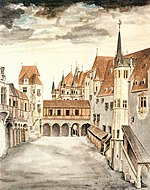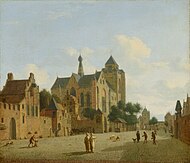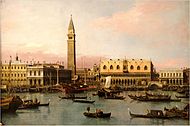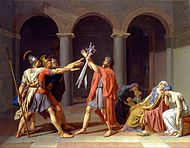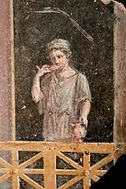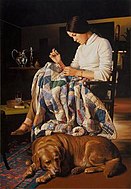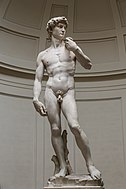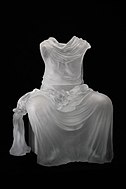Figurative art
Figurative art, sometimes written as figurativism, describes artwork (particularly paintings and sculptures) that is clearly derived from real object sources and so is, by definition, representational. The term is often in contrast to abstract art:
Since the arrival of abstract art the term figurative has been used to refer to any form of modern art that retains strong references to the real world.[1]
Painting and sculpture can therefore be divided into the categories of figurative, representational and abstract, although, strictly speaking, abstract art is derived (or abstracted) from a figurative or other natural source. However, "abstract" is sometimes used as a synonym of non-representational art and non-objective art, i.e. art which has no derivation from figures or objects.
Figurative art is not synonymous with figure painting (art that represents the human figure), although human and animal figures are frequent subjects.
Formal elements
The formal elements, those aesthetic effects created by design, upon which figurative art is dependent, include
| Sleeping Venus (a.k.a. Dresden Venus) | |
|---|---|
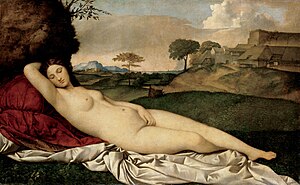 First known reclining nude in Western Art. Introduced the female nude as subject. | |
| Artist | Giorgione |
| Year | c. 1510 |
| Dimensions | 108.5×175 cm (42.7×69 in) |
Evolution
Figurative art is itself based upon a tacit understanding of abstracted shapes: the figure sculpture of
From the early Renaissance, Mannerism and the Baroque through 18th-, 19th- and 20th-century painting Figurative art has steadily broadened its parameters. An important landmark in the evolution of figurative art is the first known reclining nude in Western painting in Sleeping Venus (1510) by Giorgione.[5] It introduced the female nude as subject and started a long line of famous paintings.
In November, 2018, scientists reported the discovery of the oldest known figurative art painting, over 40,000 (perhaps as old as 52,000) years old, of an unknown animal, in the cave of Lubang Jeriji Saléh on the Indonesian island of Borneo.[6][7]
Architecture, townscape
-
Albrecht Dürer (1494) Courtyard of Innsbruck Castle
-
Jan van der Heyden (1652) The Church at Veere
-
Canaletto (c. 1737) View of the Piazzetta and The Bassin of San Marco in Venice
-
Burgos Cathedral (1851) by François Bossuet
History painting
-
Paolo Uccello (1438–1440) The Battle of San Romano
-
Christ In The House Of His Parents
-
Lawrence Alma-Tadema (1872) The Egyptian Widow
Human forms
-
Ancient Roman woman on a balcony (9–14 CE), Getty Villa
-
Kenyon Cox (1896) Nude study
-
Joseph Csaky (1911–1912) Groupe de femmes (Group of Women), plaster
-
Raymond Duchamp-Villon (1914) Femme assise, plaster
-
Ian Hornak (1978) Marcia Sewing, Variation III
-
ʿAin Ghazal statues, from approximately 9000 years ago
-
David (1504), by Michelangelo
-
Seated Dress Impression with Drapery (2005), by Karen LaMonte
-
Mother and her child by Leah Michlson.
Landscape, seascape
-
Claude Monet (1886) Rain at Eretat
-
Wheat Field with Crows (1890) by Vincent van Gogh
-
Palo Duro Canyon (1916) by Georgia O'Keeffe
Still life
-
Alexander Coosemans (c. 1660) Still Life with Lobster and Oysters
-
Paul Cézanne (1879) Nature morte au compotier
-
Henri Matisse (1899) Still Life with Compote, Apples and Oranges
Cave painting
See also
- Abstract art
- Illustration
- Narrative art
- Neofigurative Art
- Realism (arts)
- Stuckism
Notes and references
- ^ Tate. "Glossary:Figurative". Archived from the original on 3 February 2012. Retrieved 21 October 2012.
- ^ Adams, Laurie Schneider, The Methodologies of Art, pages 17-19. Westview Press, 1996,
- ^ a b Clark, Kenneth, The Nude: A Study in Ideal Form, pages 31-2. Princeton University Press, 1990.
- ^ a b The Gombrich Archive: Press statement on The Story of Art Archived October 6, 2008, at the Wayback Machine
- )
- ^ Zimmer, Carl (7 November 2018). "In Cave in Borneo Jungle, Scientists Find Oldest Figurative Painting in the World - A cave drawing in Borneo is at least 40,000 years old, raising intriguing questions about creativity in ancient societies". The New York Times. Retrieved 8 November 2018.
- S2CID 53208538. Retrieved 8 November 2018.
External links
- Figurative art at TATE.org

